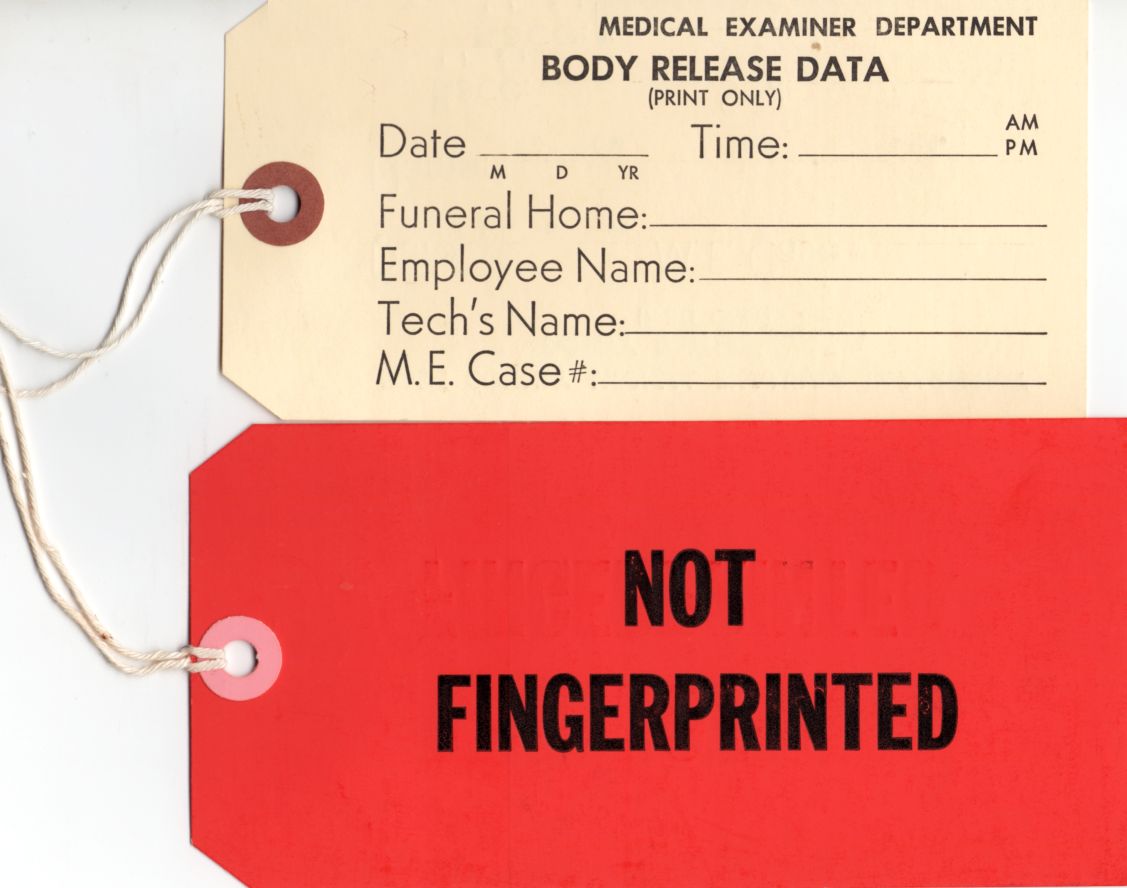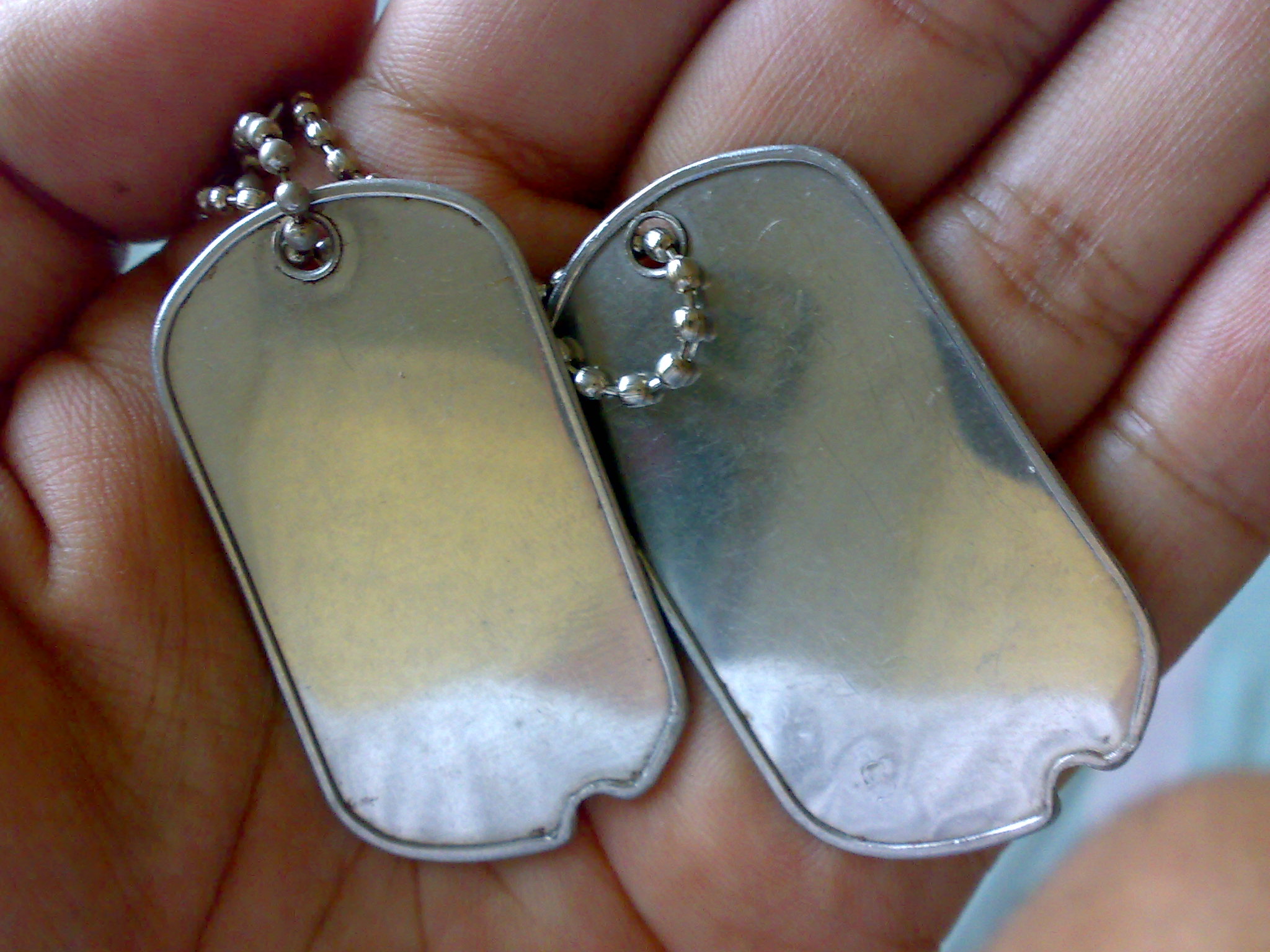 |
Toe Tag
A toe tag is a piece of cardboard attached with string to the big toe of a deceased individual in a morgue. It is used for identification purposes, allowing the mortician, coroner, law enforcement, and others involved in the death process to correctly identify the corpse. It usually bears the decedent's name, a case number if law enforcement is involved, and some descriptors like hair and eye color. In many places, actual toe tags are no longer used due to hygiene concerns but have been replaced by wrist and/or ankle bands that serve the same purpose. See also *Body bag *Dog tag Dog tag is an informal but common term for a specific type of identification tag worn by military personnel. The tags' primary use is for the identification of casualties; they have information about the individual written on them, including ... References {{DEFAULTSORT:Toe Tag Death customs Funeral-related industry Toes ... [...More Info...] [...Related Items...] OR: [Wikipedia] [Google] [Baidu] |
|
Death
Death is the end of life; the irreversible cessation of all biological functions that sustain a living organism. Death eventually and inevitably occurs in all organisms. The remains of a former organism normally begin to decompose shortly after death. Some organisms, such as '' Turritopsis dohrnii'', are biologically immortal; however, they can still die from means other than aging. Death is generally applied to whole organisms; the equivalent for individual components of an organism, such as cells or tissues, is necrosis. Something that is not considered an organism, such as a virus, can be physically destroyed but is not said ''to die'', as a virus is not considered alive in the first place. As of the early 21st century, 56 million people die per year. The most common reason is aging, followed by cardiovascular disease, which is a disease that affects the heart or blood vessels. As of 2022, an estimated total of almost 110 billion humans have died, or rou ... [...More Info...] [...Related Items...] OR: [Wikipedia] [Google] [Baidu] |
|
|
Morgue
A morgue or mortuary (in a hospital or elsewhere) is a place used for the storage of human corpses awaiting identification (ID), removal for autopsy, respectful burial, cremation or other methods of disposal. In modern times, corpses have customarily been refrigerated to delay decomposition. Etymology and lexicology The term ''mortuary'' dates from the early 14th century, from Anglo-French ''mortuarie'', meaning "gift to a parish priest from a deceased parishioner," from Medieval Latin mortuarium, noun use of neuter of Late Latin adjective mortuarius "pertaining to the dead," from Latin ''mortuus'', pp. of ''mori'' "to die" (see mortal (adj.)). The meaning of "place where the deceased are kept temporarily" was first recorded in 1865, as a euphemism for the earlier English term "deadhouse". The term ''morgue'' comes from the French. First used to describe the inner wicket of a prison, where new prisoners were kept so that jailers and turnkeys could recognize them in the fu ... [...More Info...] [...Related Items...] OR: [Wikipedia] [Google] [Baidu] |
|
|
Funeral Director
A funeral director, also known as an undertaker or mortician (American English), is a professional who has licenses in funeral arranging and embalming (or preparation of the deceased) involved in the business of funeral rites. These tasks often entail the embalming and burial or cremation of the dead, as well as the arrangements for the funeral ceremony (although not the directing and conducting of the funeral itself unless clergy are not present). Funeral directors may at times be asked to perform tasks such as dressing (in garments usually suitable for daily wear), casketing (placing the corpse in the coffin), and Desairology: Funeral Cosmetology, cossetting (applying any sort of cosmetic or substance to the best viewable areas of the corpse for the purpose of enhancing its appearance) with the proper licenses. A funeral director may work at a funeral home or be an independent employee. Etymology The term ''mortician'' is derived from the Latin word ('death') with the end ... [...More Info...] [...Related Items...] OR: [Wikipedia] [Google] [Baidu] |
|
 |
Coroner
A coroner is a government or judicial official who is empowered to conduct or order an inquest into the manner or cause of death. The official may also investigate or confirm the identity of an unknown person who has been found dead within the coroner's jurisdiction. In medieval times, English coroners were Crown officials who held financial powers and conducted some judicial investigations in order to counterbalance the power of sheriffs or bailiffs. Depending on the jurisdiction, the coroner may adjudge the cause of death personally, or may act as the presiding officer of a special court (a " coroner's jury"). The term ''coroner'' derives from the same source as the word '' crown''. Duties and functions Responsibilities of the coroner may include overseeing the investigation and certification of deaths related to mass disasters that occur within the coroner's jurisdiction. A coroner's office typically maintains death records of those who have died within the coroner's juri ... [...More Info...] [...Related Items...] OR: [Wikipedia] [Google] [Baidu] |
 |
Cadaver
A cadaver, often known as a corpse, is a Death, dead human body. Cadavers are used by medical students, physicians and other scientists to study anatomy, identify disease sites, determine causes of death, and provide tissue (biology), tissue to repair a defect in a living human being. Students in medical school study and dissect cadavers as a part of their education. Others who study cadavers include archaeologists and arts students. In addition, a cadaver may be used in the development and evaluation of surgical instruments. The term ''cadaver'' is used in courts of law (and, to a lesser extent, also by media outlets such as newspapers) to refer to a dead body, as well as by recovery teams searching for bodies in natural disasters. The word comes from the Latin word ''cadere'' ("to fall"). Related terms include ''cadaverous'' (resembling a cadaver) and ''cadaveric spasm'' (a muscle spasm causing a dead body to twitch or jerk). A cadaver graft (also called “postmortem graft”) ... [...More Info...] [...Related Items...] OR: [Wikipedia] [Google] [Baidu] |
 |
Body Bag
A body bag, also known as a cadaver pouch or human remains pouch (HRP), is a non-porous bag designed to contain a human body, used for the storage and transportation of shrouded corpses. History In the United States, the apparent first documented bag for the purpose of transporting bodies was patented under the name "Improvement in Receptacles for Dead Bodies." The patent was filed during the Civil War by Dr. Thomas Holmes, United States Patent No. 39, 291. The purpose of the bag, as stated in the patent application dated July 21, 1863 was, "...to facilitate the carrying of badly-wounded dead bodies hurriedly away that could not otherwise be quickly removed for the want of proper conveyances, or difficulty to procure boxes or coffins for removing the dead, as the boxes or coffins cannot be so easily transported or handled on the field of battle." He said that he'd "invented a new and useful Elastic and Deodorizing Receptacle." Uses Body bags can also be used for the storag ... [...More Info...] [...Related Items...] OR: [Wikipedia] [Google] [Baidu] |
 |
Dog Tag
Dog tag is an informal but common term for a specific type of identification tag worn by military personnel. The tags' primary use is for the identification of casualties; they have information about the individual written on them, including identification and essential basic medical information such as blood type and history of inoculations. They often indicate a religious preference as well. Dog tags are usually fabricated from a corrosion-resistant metal. They commonly contain two copies of the information, either in the form of a single tag that can be broken in half, or as two identical tags on the same chain. This purposeful duplication allows one tag, or half-tag, to be collected from an individual's dead body for notification, while the duplicate remains with the corpse if the conditions of battle prevent it from being immediately recovered. The term arose and became popular because of the tags' resemblance to animal registration tags. Although typically worn around ... [...More Info...] [...Related Items...] OR: [Wikipedia] [Google] [Baidu] |
 |
Death Customs
Death is dealt with differently in cultures around the world, and there are ethical issues relating to death, such as martyrdom, suicide and euthanasia. Death refers to the permanent termination of life-sustaining processes in an organism, i.e. when all biological systems of a human being cease to operate. Death and its spiritual ramifications are debated in every manner all over the world. Most civilizations dispose of their dead with rituals developed through spiritual traditions. Disposal of remains In most cultures, after the last offices have been performed and before the onset of significant decay, relations or friends arrange for ritual disposition of the body, either by destruction, or by preservation, or in a secondary use. In the US, this frequently means either cremation or interment in a tomb. There are various methods of destroying human remains, depending on religious or spiritual beliefs, and upon practical necessity. Cremation is a very old and quite common cus ... [...More Info...] [...Related Items...] OR: [Wikipedia] [Google] [Baidu] |